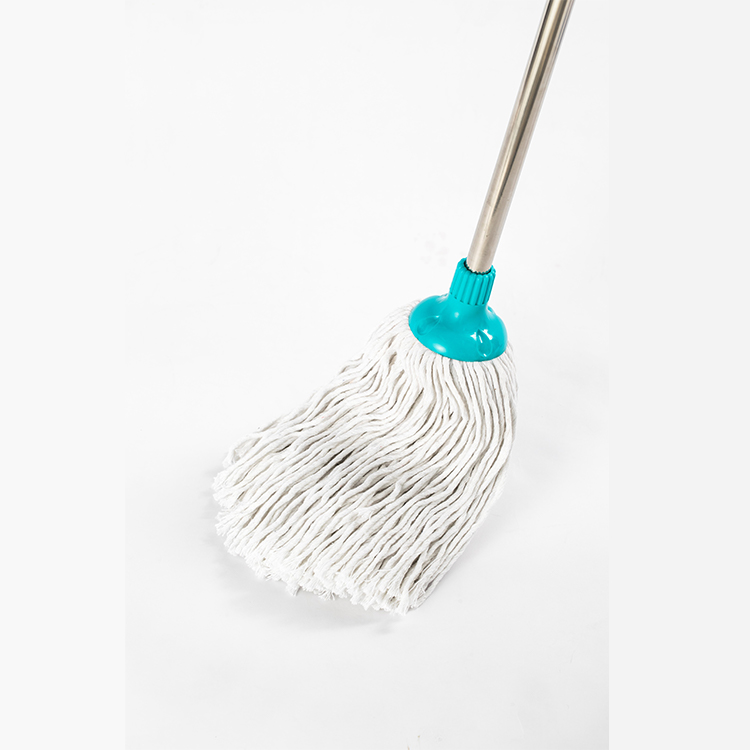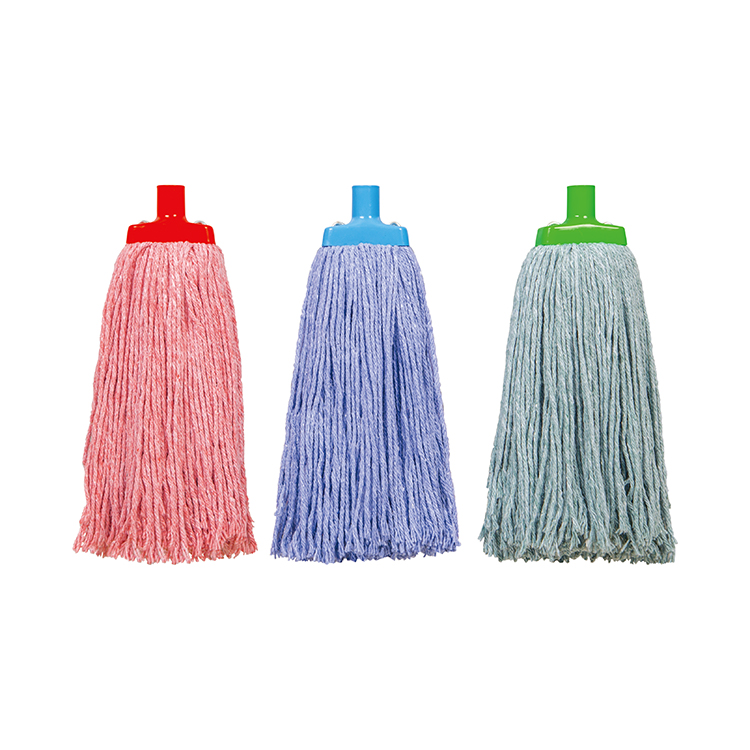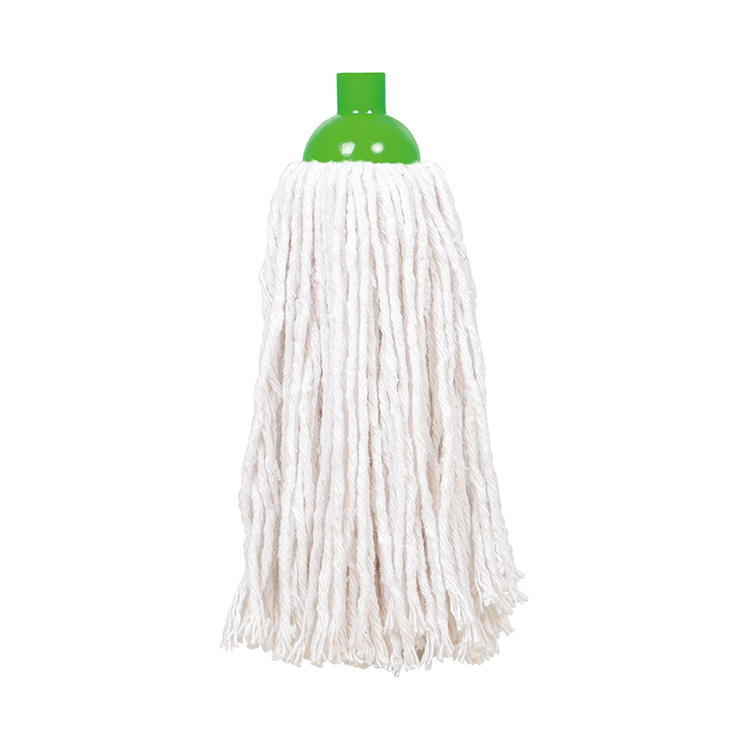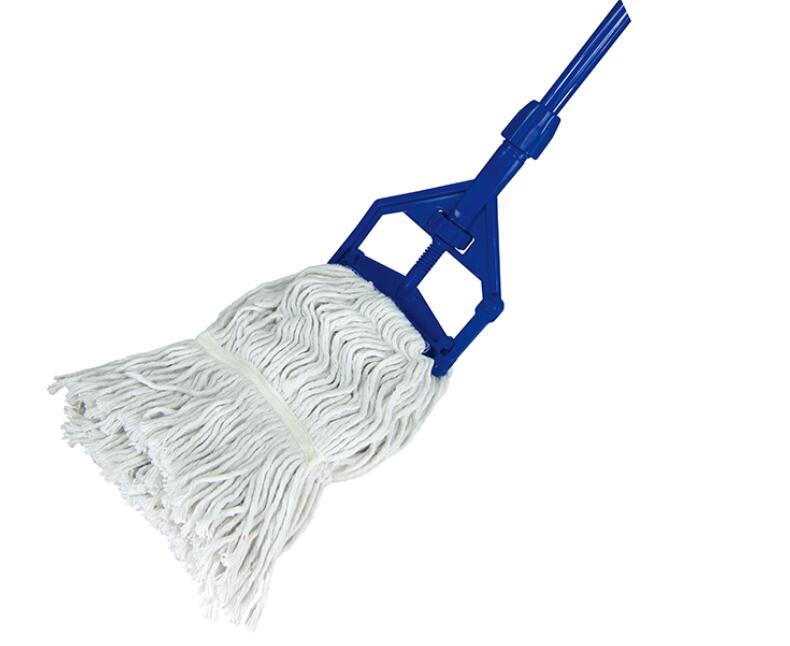How to Prevent Mildew and Odor in Cotton Mop?
Cotton mops are an effective tool for cleaning floors, but they can develop mildew and odor if not properly cared for. Mildew and odor can be not only unpleasant but also harmful to your health.
Here are some tips you should follow to make sure your cotton mop is properly disposed of after helping you clean it. By following these tips, you can ensure that your cotton mop remains an effective cleaning tool for years to come.
Proper storage
After using your cotton mop, it's essential to store it properly to prevent mildew and odor. Hang the mop in a well-ventilated area to allow air to circulate around it. Avoid storing the mop in a damp or humid area, such as a closet or basement. If you don't have a suitable area to hang your mop, consider investing in a mop holder or rack.Wash after every use
To prevent mildew and odor, it's crucial to wash your cotton mop after every use. Rinse the mop thoroughly in hot water, and then hang it up to dry. If you don't have time to wash the mop after every use, at least rinse it out with hot water to remove any dirt and debris.Use a disinfectant
To kill any bacteria or germs that may be lurking in your cotton mop, use a disinfectant when washing it. You can add a capful of disinfectant to a bucket of hot water, and then soak the mop in the solution for a few minutes before rinsing it out. Be sure to read the instructions on the disinfectant to ensure that it's safe to use on your cotton mop.Replace the mop head regularly
Even with proper care, cotton mop heads will eventually wear out and need to be replaced. A worn-out mop head is more likely to develop mildew and odor and may not clean your floors effectively. Replace the mop head every three to six months or when it shows signs of wear and tear.Air dry completely
After washing your cotton mop, be sure to let it air dry completely before storing it away. A damp mop can easily develop mildew and odor, so it's essential to let it dry completely before putting it away. You can also hang the mop in the sun to dry, as sunlight has natural disinfectant properties.To sum up, preventing mildew and odor in your cotton mop is essential to keep your floors clean and hygienic. Proper storage, regular washing, using a disinfectant, replacing the mop head regularly, and air-drying are all important steps in preventing mildew and odor in your cotton mop.
When Should You Replace Your Cotton Mop Head?
Cotton mop heads are an essential tool for maintaining clean floors. They are widely used in homes, businesses, and institutions to scrub away dirt and grime.
However, like any cleaning tool, they wear out over time and need to be replaced.
Worn-out fibers
One of the most obvious signs that your cotton mop head needs to be replaced is when the fibers are worn out. Over time, the fibers on the mop head will become frayed and flattened, making it less effective at picking up dirt and debris. If you notice that your mop head is no longer picking up dirt as effectively as it used to, it's time to replace it.Foul odor
If your cotton mop head starts to emit a foul odor, it's time to replace it. Over time, bacteria and other germs can accumulate on the mop head, causing it to develop an unpleasant smell. No amount of washing will eliminate the odor, and using a smelly mop can actually make your floors smell worse. Replacing the mop head will ensure that you are using a clean and fresh-smelling tool to clean your floors.Stains
If your cotton mop head has stubborn stains that won't come out, it's time to replace it. Even with regular washing, mop heads can accumulate stains from spilled liquids and other substances. These stains can be unsightly and can make your mop head less effective at cleaning your floors. If you notice that your mop head has stains that won't come out, it's best to replace them.Tears and holes
If your cotton mop head has tears or holes, it's time to replace it. Tears and holes can occur from regular use or from snagging on rough surfaces. A mop head with tears and holes will not be effective at cleaning your floors and can actually cause damage to your floors if any sharp objects are exposed. It's important to replace the mop head as soon as you notice any tears or holes.Excessive shedding
If your cotton mop head is shedding fibers excessively, it's time to replace it. Shedding can occur when the mop head is old and worn out or when the fibers are not secured tightly enough to the mop head. Excessive shedding can make cleaning your floors more difficult and can even leave behind more dirt and debris than you started with.
How Often Should I Replace My Cotton Mop Head?
The frequency of replacement will depend on how often you use the mop and how well you take care of it. However, as a general rule of thumb, it's a good idea to replace your cotton mop head every three to six months.Can I Repair My Cotton Mop Head If It Has Tears or Holes?
It's possible to repair small tears or holes in your cotton mop head with a needle and thread. However, if the damage is extensive, it's usually best to replace the mop head altogether.Can I Use a Worn-Out Mop Head?
It's never a good idea to use a dirty or worn-out mop head, even in a pinch. A dirty mop head can spread germs and bacteria around your home or business, while a worn-out mop head will not clean your floors effectively and can even cause damage to your floors. It's always best to use a clean and effective mop head for optimal cleaning results.Conclusion
It's important to replace your cotton mop head when it starts to show signs of wear and tear. By keeping an eye out for these signs, you can ensure that your floors stay clean and hygienic. Whether it's worn-out fibers, foul odor, stains, tears, and holes, or excessive shedding, replacing your mop head will ensure that you are using an effective and safe tool to clean your floors.Common Mistakes to Avoid When Using a Cotton Mop
Cotton mops are a popular cleaning tool used in homes and businesses around the world. They are effective at cleaning a variety of surfaces and are relatively easy to use.
However, there are some common mistakes that people make when using cotton mops that can impact their effectiveness and lifespan.
In this article, we'll discuss some of the most common mistakes to avoid when using a cotton mop.
Not wringing out the mop head properly
One of the most common mistakes people make when using cotton mops is not wringing out the mop head properly. If the mop head is too wet, it can leave streaks on the floor and make it difficult to dry. Conversely, if the mop head is too dry, it may not be effective at cleaning the surface. To avoid this mistake, make sure to wring out the mop head thoroughly before using it.Using the wrong cleaning solution
Another common mistake people make is using the wrong cleaning solution with their cotton mop. Some cleaning solutions may be too harsh and can damage the mop head over time. It's important to read the label of the cleaning solution to ensure that it is safe to use with cotton mop heads.Not cleaning the mop head after each use
Failing to clean the mop head after each use can lead to the buildup of dirt and bacteria, which can impact the effectiveness of the mop and lead to unpleasant odors. To avoid this mistake, rinse the mop head thoroughly after each use and allow it to dry completely before storing it.Not replacing the mop head when it's worn out
Using a worn-out mop head can be ineffective and potentially unsanitary. If the mop head is showing signs of wear and tear, such as fraying or holes, it's time to replace it. A good rule of thumb is to replace cotton mop heads every three to six months, depending on how frequently they are used.Not storing the mop head properly
Proper storage is essential to ensuring the longevity of a cotton mop head. Storing a wet mop head can lead to the growth of mold and mildew while storing it in a damp or humid area can cause it to deteriorate more quickly. To avoid these issues, make sure to store the mop head in a dry, well-ventilated area.It's important to remember that using a cotton mop correctly can not only extend the lifespan of the mop head but can also ensure that our floors and surfaces are cleaned effectively and hygienically. By avoiding these common mistakes, we can get the most out of our cotton mops and keep our homes and businesses looking clean and fresh.
In addition to these common mistakes, there are a few other tips to keep in mind when using a cotton mop.
First, make sure to choose the right mop for the job.
Different types of mop heads are designed for different types of surfaces, so be sure to choose a mop head that is appropriate for the surface you are cleaning.Second, consider using microfiber mop heads.
Microfiber mop heads are becoming increasingly popular due to their effectiveness at picking up dirt and debris. Microfiber mop heads are also more durable than traditional cotton mop heads and can be washed and reused multiple times.Finally, make sure to follow the manufacturer's instructions for cleaning and maintaining your cotton mop.
It will help to ensure that your mop head lasts as long as possible and remains effective at cleaning surfaces.How Long Do Cotton Mop Heads Typically Last?
Cotton mops have been a staple cleaning tool for households and businesses for decades. They are known for their absorbent qualities and ability to effectively clean floors and surfaces.
Cotton mop heads are a popular cleaning tool for floors and surfaces in homes and businesses around the world. These mop heads are known for their absorbent properties and ability to effectively clean a variety of surfaces.
How Long Do Cotton Mop Heads Typically Last?
The lifespan of a cotton mop head can vary widely depending on a variety of factors, including the frequency of use, the type of surface being cleaned, and the quality of the mop head itself. Generally speaking, a cotton mop head can last anywhere from a few weeks to several months.
One of the biggest factors that can impact the lifespan of a cotton mop head is the frequency of use.
If a mop head is used multiple times per day, it may wear out more quickly than one that is only used once a week. Additionally, the type of surface being cleaned can also impact the lifespan of a cotton mop head. Rough or abrasive surfaces can cause the mop head to wear out more quickly than smooth surfaces.The quality of the mop head itself is also an important factor to consider.
Higher-quality cotton mop heads are typically made with more durable materials and constructed with better stitching, which can make them last longer than lower-quality mop heads. When purchasing cotton mop heads, it's important to look for ones that are made from high-quality materials and are constructed with care.To ensure that cotton mop heads last as long as possible, proper care and maintenance are essential. After each use, the mop head should be thoroughly rinsed and wrung out to remove any excess water or debris. It's also a good idea to wash the mop head regularly to prevent the buildup of dirt and bacteria.

Replace Your Clean Floor Mop Regularly
In addition to proper care and maintenance, there are some signs that it may be time to replace a cotton mop head. One of the most obvious signs is visible wear and tear, such as fraying or holes in the mop head. If the mop head is no longer absorbing water or cleaning surfaces effectively, this may also be a sign that it needs to be replaced.
Using a worn-out cotton mop head can not only be ineffective, but it can also be unsanitary. Over time, bacteria can build up in the mop head, which can spread to other surfaces and potentially cause illness. For this reason, it's important to replace cotton mop heads when they show signs of wear or are no longer effective.
When it comes to disposal, cotton mop heads should be disposed of responsibly to minimize their environmental impact. If the mop head is made of organic cotton, it can be composted, which is an eco-friendly option. If the mop head is not compostable, it should be disposed of in the trash.
Ultimately, the lifespan of a cotton mop head can vary widely depending on a variety of factors. While some mop heads may only last a few weeks, others may last several months with proper care and maintenance.
By choosing high-quality mop heads, using them appropriately, and taking care of them properly, we can extend their lifespan and get the most out of this essential cleaning tool.
What’s the Difference Between Dry Floor Mops and Floor Wet Mops?
Cleaning your floors is an essential part of maintaining a healthy and hygienic home. To keep your floors free of dirt, dust, and other debris, you need to invest in the right household cleaning tools.
Two popular household cleaning tools that many people use are dry and wet mops. While both types of mops are used to clean floors, they work differently, and it is important to know the difference between them to use them effectively.
Dry Floor Mops
A dry dust mop is a type of cleaning tool that is designed to remove dust, dirt, and other debris from your floors. It is typically made from a material such as a microfiber or cotton, which is specially designed to attract and hold onto dust and dirt. Dry dust cleaning mops are typically used to clean hard floors, such as wood, tile, and laminate.
The advantage of using a dust mop is that it is very effective at picking up dust and other debris from your floors. Because it does not require any water, it is also very easy and quick to use. Dust mops are also very gentle on your floors and will not scratch or damage them in any way.
Floor Wet Mops
Wet mops, on the other hand, are used to clean floors that are dirty or have spilled liquids on them. They are designed to be used with water and a cleaning solution, and they are made from materials such as microfiber, cotton, or sponge.
Using a wet mop is that it can help to remove stubborn dirt and grime from your floors. It can aid in disinfecting your floors and getting rid of any bacteria or germs that might be there when it is used with water. Additionally incredibly adaptable, floor wet mops can be used to clean a wide range of different surfaces.
Difference Between Dry Floor Mops and Floor Wet Mops
There are several key differences between dry and wet mops that you should be aware of.
First, dry mops are designed to be used without water, while wet mops require water to be effective.
Second, dry mops are used to remove dust and other debris from your floors, while wet mops are used to clean floors that are dirty or have spilled liquids on them.
Another difference between dry floor mops and floor wet mops is the type of floors they can be used on. Dry mops are generally used on hard floors, while wet mops can be used on a variety of different surfaces, including tile, wood, and laminate.
The Use of Dry Floor Mops and Floor Wet Mops
The way that you use dry and wet mops are also different.
When using a dry mop, you simply sweep it over your floors to remove dust and debris.
When using a wet mop, you first need to prepare a cleaning solution and wet the mop before using it to clean your floors. Wet mops also need to be wrung out regularly to remove excess water, which can damage your floors.
In conclusion, dry and wet mops are both important tools for keeping your floors clean and hygienic. Dry mops are best for removing dust and debris from hard floors, while wet mops are best for cleaning up spills and removing dirt and grime from a variety of different surfaces.
By understanding the differences between these two types of floor cleaning mop, you can choose the right household cleaning tools for the job and keep your floors looking their best.

